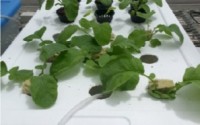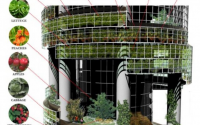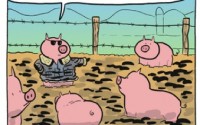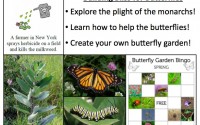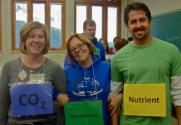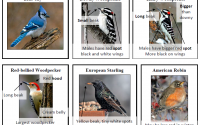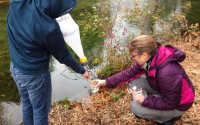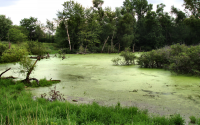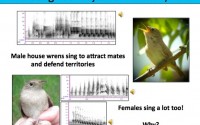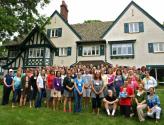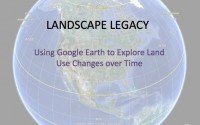The aim of this project is to help students to gain deeper understanding on how and why mineral elements are necessary for plants to grow. Plants will exhibit certain symptoms of nutrition deficiency when suffering from malnutrition, which can be best studied by a water culture (hydroponics) system. This lesson starts with a brief introduction on what plant nutrition is and why fertilizer is important for plants. After the theory session, instructors and students will build seed starting and hydroponics experimental systems together. Different treatments, i.e. nutrient solutions that are absent of certain mineral elements, will be set up and students will be divided into small groups to observe how plants react and adjust under various environments. Students will spend time on 1) recording plant nutrient deficiency symptom; 2) maintaining hydroponics systems; 3) collecting plant morphological and physiological data. At […]
When mountains disappear where do they go? Inorganic carbon cycling in your belly and our ecosystems
In this lesson, students will learn about the “other” carbon, that is, inorganic carbon and how it is important for understanding how mountains erode over millennia, how farmers utilize it to maintain soil health, and its role in the carbon cycle. This lesson will introduce students to the scale at which ecosystem ecology works. A small lab activity demonstrates the chemical reaction at the heart of this lesson (involving TUMS, hence “inorganic carbon cycling in your belly”). The lesson involves working with a scientific journal article and data from it. The journal article illustrates how scientists quantify how humans affect the ecosystem, more specifically, how the inorganic carbon in the river water tells a story about how humans use the land. Together, we walk through a series of graphs from the paper to arrive at conclusions by synthesizing information from […]
Running the Gauntlet: Finding the Least-Cost Path
Animals move across the landscape for many reasons – such as migration, dispersal, or simply to find enough food. These movements often force animals to move through less-than-ideal habitat where they’re more exposed to predators or dangers associated with human activity (think of a deer moving out of a forest to cross a highway). Because not all habitats making up a landscape are the same, there are often more- and less-costly paths an animal can take as it moves from one point to another. In this lesson students will explore the costs of moving across a complex landscape. The students’ goal is to find the least-cost (i.e. safest) path for a particular animal given knowledge of that animal’s habitat needs and preferences and the dangers associated with different habitats. At the conclusion of the lesson, students will be able to: […]
The Good, The Bad and The Ugly: Species Interactions
Interactions are a way of life. All organisms interact with many other organisms on a daily basis. Some of these interactions are positive, benefitting all organisms involved. Some of these interactions are negative, which may cause harm. Plants, animals and all other living things interact, and these many interactions are readily observable in our own backyards. In this activity we will explore these interactions and predict how they will help or harm species when their environment changes (biotic or abiotic changes). At the conclusion of the lesson, students will be able to: Identify interactions between different species (observation) Name and describe the different types of species interactions Recognize that species may develop more than one relationship Predict the impact of environmental changes (biotic or abiotic) on the relationship or individual organism Resources: Lesson plan Powerpoint Game worksheet Elementary graphing activity […]
Fellow Amanda Charbonneau featured on BEACON website
Check out GK-12 Fellow Amanda Charbonneau’s research on invasive species this week at the BEACON blog: http://beacon-center.org/blog/2014/06/16/beacon-researchers-at-work-what-makes-invasive-species-successful/
Comstock and GK-12 partner to participate in NestWatch
GK-12 Fellow and ornithologist Cara Krieg and Comstock STEM academy teacher Mary Grintals worked together to get STEM academy students outside and directly observing and recording bird nesting behavior! In April, Cara Krieg donated 10 cedar bird nestboxes to the STEM academy and helped the students site and install them in good locations to attract birds. Cara researches house wrens at Lux Arbor Reserve, a research property managed by the Kellogg Biological Station. Her research includes maintaining a vast network of nest boxes for the wrens so she was able to give the Comstock students some very practical advice to assist with their nest monitoring experience. Mary Grintals recruited her 5th grade students to participate in a nationwide, citizen science nest monitoring program run by the Cornell Lab of Ornithology, called Nest Watch. The students learned where birds nest (other […]
Plenary speakers at the K-12 Partnership Summer Institute
The 2014 KBS K-12 Partnership, sponsored by the NSF GK-12 and KBS LTER, invites you to join us for our morning plenary research talks at the Summer Institute. Events will run from Monday June 23 – Wednesday June 25. Plenary talks will be in the KBS Auditorium from 8:30 – 9:30 AM each day. Monday June 23, 8:30-9:30 AM Dr. Jason Gallant MSU Zoology Talk Title: Shocking tails from around the world: electric fish in the genomics era Brief excerpt from online bio: I completed my postdoctoral research in July, 2013 working in the evolutionary genetics laboratory of Sean Mullen at Boston University, where I studied the genetic basis of mimetic wing patterns in Limenitis and Heliconius butterflies. I received my Ph.D. in July 2011, working with Carl Hopkins and David Deitcher at Cornell University. Here, I studied the evolution of signal form and electric organ morphology among the Mormyrid electric […]
2014 Summer Institute – June 23-25
The KBS K-12 partnership cordially invites you to the 2014 Summer Institute! Mark your calendars for this three day event, from Monday June 23 through Wednesday June 25. The schedule will run from 8 AM to 4 PM each day. Below you’ll find our daily agendas well as details on our plenary sessions and concurrent sessions. Events will continue to update as we develop content. Please rsvp to Sarah at bodbyl@msu.edu if you plan to attend. We look forward to seeing you! ***Please note: This year we will be capping a $75/day stipend for teacher attendees to the first 60 with an rsvp.*** Agenda Drafts (click to view): Agenda -DAY 1 Agenda -DAY 2 Agenda -DAY 3 Concurrent Session Abstracts: Cosmos, Part Deux!! With Lisa Wininger, Stack 145, EL/MS, Monday at 1 PM In this session, elementary and middle school teachers will learn about […]
GK-12 Fellows receive spring awards
Congratulations to former GK-12 fellows Cara Krieg, Melissa Kjelvik, and Liz Schultheis for receiving awards to further their research. Cara Krieg received the 2014 George J. Wallace and Martha C. Wallace award, supporting ornithological research, from the Zoology department. Cara’s research focuses on unexpected behaviors observed in female house wrens, specifically female-female aggression and female song. Follow along with Cara’s research at her summer blog. Melissa Kjelvik and Liz Schultheis were awarded a grant from NIMBIOS – the National Institute for Mathematical and Biological Synthesis (http://www.nimbios.org/). The grant funds will be used to continue to develop and evaluate an exciting educational tool they developed while in the GK-12 program, called Data Nuggets. Check out the Data Nugget website.
Gull Lake students learn about native plants
In mid-May, Gull Lake 8th graders learned about landscaping with native plants with the help of fellows Tyler Bassett and Brendan O’Neill. Friday, May 16 was cool and a bit rainy, but that didn’t stop Jamie Bowman’s 8th grade class from planting nearly 300 native plugs at the Gull Lake Middle school. Tyler and Brendan took turns helping the students settle the plants and teach them about some of the benefits of native plant landscaping, including: improved wildlife habitat, erosion and run-off control, and reduced water use. Ms. Bowman hopes plans to use the newly planted area in future years as an extension of the BEST plots and the Gull Lake Outdoor Classroom, which includes lake access and a greenhouse. Students have used the outdoor classroom to sample lake water for water quality analyses, learn about aquatic invertebrate life, and […]
Bringing Biology to Urban Design: All Aboard the Poop Train!
There has been a significant shift in human populations toward urban areas, which in conjunction with the growing global population has increased the demand for resources like food and energy. In order to satisfy these demands, we must find ways to produce food and energy more sustainably and increase our energy efficiency. Some of the ways we try to accomplish these goals involve taking inspiration from biological systems. This two-part lesson will outline many of the ways that we have applied what we know about nature to make urban systems more sustainable, build in ways that reduce energy demand or increase efficiency, and manage our waste more effectively. At the conclusion of the lesson, students will be able to: Explain why there is an increasing demand for resources in urban areas Explain biologically-inspired strategies for providing food sustainably Explain how […]
The Pig Bang Theory: Implications of Ignoring Evolution
What do pest-resistant corn, antibiotic resistance and pig farm explosions have in common? Sometimes nature fights back against our attempts at environmental engineering, and we must change tactics accordingly. Humans spend huge amounts of money and time to improve crops or domestic animals, and increasingly, we are finding that evolution can creatively side-step our intended goals. For instance, pest-resistant crops have resulted in new breeds of insects that are immune to our poisons. Modern farmers must find ways to prevent not only damage to their current crops, but evolution in pest populations that will eat their future fields. This lesson will focus on how evolution can hamper our efforts, and have explosive consequences. Students will learn how evolution happens in pest populations and have an opportunity to think critically about a current problem in agriculture using claims, evidence, and reasoning. […]
Building Bliss for Butterflies
Human impacts on the environment are progressively altering ecosystems across the world. In this lesson we explore the dramatic effects of these human impacts on a well-known example, Monarch butterflies, and introduce realistic steps students can take to help address this problem. In the first part of this lesson students will play a game where they will learn the hazards facing Monarch butterflies on their annual migration from Mexico to the Midwest. In the middle of the lesson students will learn how to build a butterfly garden at their schools that will provide critical breeding resources to Monarchs as well as attract and support other butterfly species. We provide resources where you can find milkweed seeds to plant in your own garden. At the end of the lesson we provide a Butterfly Garden Bingo exercise to help students explore other […]
Royer and Schultheis publish BoxCar2D lesson in ABT journal
GK-12 Fellows Anne Royer and Liz Schultheis published a paper in the April issue of American Biology Teacher on the use of the evolution simulation software, BoxCar2D, in the classroom. Many of you will recognize the activity from previous K-12 workshops, where Anne and Liz refined the lesson and received helpful feedback from partnership teachers. Congratulations to Anne and Liz! Royer, A. M. and E. H. Schultheis. 2014. Evolving better cars: Teaching evolution by natural selection with a digital inquiry activity. The American Biology Teacher. 76(4):259-264 For a PDF copy of the manuscript, please email GK-12 leadership at kbsgk12project@kbs.msu.edu
April 23, 2014 Workshop – STEM: Environmental Engineering for Sustainability
The KBS K-12 partnership cordially invites you to: STEM: Environmental Engineering for Sustainability Wednesday, April 23 from 8 AM to 4 PM. Below you’ll find our agenda for the day as well as details on our concurrent sessions. Events will continue to update as we develop content. Please rsvp to Sarah at bodbyl@msu.edu if you plan to attend. We look forward to seeing you! Agenda 8:00 AM Breakfast, Announcements, and Introductions 8:30 AM Speaker: Dawn Reinhold (Assistant Professor of Biosystems and Agricultural Engineering at MSU) – Auditorium 9:30 AM Concurrent Session Teasers 9:45 AM Concurrent Session 1 MS/HS: Bread Making as Biological Engineering (Kolonich, Lee, Doherty and Anderson) Terrace Room EL (elem): Bringing Biology to Urban Design: All aboard the Poop Train! (Jake Nalley and Sara Garnett) Stack 140 MS/HS: The Pig Bang Theory: The Implications of Ignoring Evolution (Amanda Charbonneau […]
MSU Grad. at a Glance profiles Krieg
The research of GK-12 Fellow Cara Krieg was recently featured in Grad. at a Glance, part of MSU Today. Read the article HERE and be sure to congratulate Cara on her accomplishments if you see her!
Russ Stolberg awarded Calhoun Conservation District Educator of the Year Award
On February 27th, Russ Stolberg, a GK-12 partner teacher from Olivet Middle School, was awarded the 2013 Educator of the Year award from the Calhoun Conservation District at their annual meeting held at FireKeeper’s Casino Hotel. This past year, Russ partnered with the Michigan Department of Natural Resources to bring the “Salmon in the Classroom” program in his 8th grade Earth Science classes where students helped rear almost 100 King salmon throughout the school year. This project culminated in a student led fish release into the Red Cedar at Michigan State University where Michigan DNR and MSU Fisheries and Wildlife representatives spoke with students about what life after release would be like for the salmon, including discussing river ecology and identifying aquatic invertebrates. Russ also has a strong partnership with the Calhoun Conservation District, this year they provided the 8th […]
What’s in My Backyard? Identifying Winter Birds in Michigan
Although winter may seem like a life-less frozen wasteland here in Michigan, many birds spend the winter here. Some arctic birds even come down to Michigan to escape the cold! Many of these winter birds can be easily attracted to backyard feeders, particularly since food is in short supply. In this lesson students will learn how to identify the 16 most common feeder birds in Michigan and will be introduced to 8 other less common species. Students will learn how scientists classify and identify species. This lesson also provides materials necessary for students to collect data from their own bird feeder and tools to contribute their data to citizen science efforts like the Great Backyard Bird Count or Cornell’s eBird tracking program that help scientists monitor bird populations across the United States. At the conclusion of the lesson, students will […]
Winter is for the Birds!
Students in Comstock have been having some strange encounters of the feathered kind. Fifth graders at the STEM Academy have been learning about the kinds of birds that will visit winter feeders. Although the world might seem like a harsh polar-vortex tundra this time of year, many native birds stay here in Michigan. Some arctic birds even migrate down to Michigan for the winter to escape the cold temperatures! GK-12 fellow Cara Krieg taught Mrs. Grintal’s students how to identify the different Michigan birds common at this time of year. The class was so excited about this lesson that they were identifying birds outside the classroom window the next day. Students will use the skills they practiced in this lesson to count birds at a feeder outside of their classroom. The data they collect will contribute to citizen science efforts […]
Sex Changes, Drugs, and Rockin’ Dead Zones: A trifecta of lessons
This lesson consists of 3 activities, all interrelated yet can be split into individual lessons as well. The overall theme of the lessons are to investigate the effect human introduced contaminants into aquatic systems have on individual organisms, populations, communities, and ecosystems. We will investigate how farming in the “Bread Basket” of America can contribute to a growing “Dead Zone” in the Gulf of Mexico and then create our own dead zones in lab. Students can then become a participant in the formation of dead zones in an interactive simulation/game. The final component of the lesson focuses on investigating the effect a novel (or never before seen) contaminant has on vulnerable frog populations. At the conclusion of the lesson, students will be able to: Describe how a dead zone occurs – from the human sources of pollution to how it […]
Where the Wild Things Are: How Rainfall Drives Food Web Interactions
Every organism, large and small, is affected by weather. Some organisms like plants are affected directly by rainfall. Others are impacted through their food chain relationships. In the hot-dry tropics found in some parts of Africa, seasonal patterns of rainfall drive one of the most impressive animal migrations in the world. This activity uses the great African migration to review the water cycle and emphasize how food webs are strongly impacted by rainfall patterns through a hands-on activity. The food web portion of this exercise can be used independently as a hands-on alternative to pen-and-paper models to review food webs, food web vocabulary, or the importance of biodiversity in ecosystems. The food web exercise also contains additional scenarios that explore: 1. The importance of taking food webs and animal behavior into account when planning wildlife reserves, 2. How human-animal conflicts […]
Wetlands: Not just a swampy place
Wetlands are a ubiquitous part of the southwestern Michigan landscape and provide numerous important ecological services. Wetlands allow water to slowly filter into the ground, which cleans water, provides a buffer against flooding, and re-charges groundwater supplies. They also provide habitat for many animal and plant species. Wetlands provide an opportunity for students to explore parts of the water cycle, food webs, and many other ecological processes. In this lesson, students learn about different types of wetlands and how they work through a series of presentations, games, and hands-on activities. At the conclusion of the lesson, students will be able to: Understand how wetlands affect water, wildlife, and ecological processes Understand how wetlands help prevent pollution and erosion Recognize that wetlands are complex systems that support many different forms of life, from top-predators to microscopic organisms Resources: Lesson plan Powerpoint (pdf) […]
Chi-Square tests: When and how to use
Researchers often need to decide if the results they observe in an experiment are close enough to predicted theoretical results so that the tested hypothesis can be supported or rejected. For example, do a series of coin flips match what you’d expect to get by chance, or is their evidence the coin is unfair? Does the number of women interviewed for a job position match the proportion of women in the applicant pool, or is there evidence of bias? Does the number of white-eyed fruit fly offspring match the number expected if the white-eyed trait is recessive, or are white-eyes inherited in some other way? In this lesson, students will able to: Decide when it is appropriate to use a chi-square goodness-of-fit test Use a chi-square test, interpret the results, and create evidence-based conclusions Use a chi-square test on real […]
GK-12 program featured on WKAR radio
This week, GK-12 PI and Zoology department chair, Tom Getty, was interviewed by WKAR (PBS, NPR affiliate from MSU) for a radio broadcast highlighting the GK-12 project at the Kellogg Biological Station. You can listen to the broadcast by clicking the link below.
Call for 2014-2015 GK-12 Fellows
The KBS GK-12 Bioenergy Sustainability Project is now accepting applications for graduate student fellowships for 2014-15. This graduate training project is funded by grant from the NSF Division of Graduate Education. Fellowships are intended for students who have completed their first year of graduate coursework. The NSF GK-12 program is meant to advance the professional development of STEM graduate students while they continue to make good progress on their dissertation research. NSF stipulates that fellows will spend a maximum of 15 hours per week directly involved in GK-12 project activities, with approximately 10 of these hours devoted to activities in K-12 partner districts or at KBS. KBS activities will include a one-day orientation in May, an intensive summer science institute in late June, two one-day school year workshops and weekly Friday fellows meetings associated with a course focused on […]
K-12 Partnership Recognized at Gobles STEM assembly
On Thursday, November 21, Gobles Public Schools announced that it would be launching a special Science, Technology, Engineering, and Mathematics education program (STEM) that will increase student exposure to cutting-edge science. GK-12 Fellow Cara Krieg (second from left, below) took the stage at the middle/high school assembly to represent the MSU KBS K-12 Partnership, along with Michigan Lieutenant Governor Brian Calley, Representative Aric Nesbitt, Senator John Proos, and school leaders. The K-12 partnership would like to thank Gobles for the recognition at this important event and look forward to continuing to work with the teachers and students to improve science education at Gobles in the years to come. Coverage of the announcement can be viewed by clicking the image above (Channel 3 video story) and visiting the Gobles district homepage here.
Project GREEEN update
Earlier this year at the spring (March 21) KBS K-12 Partnership workshop, we partnered with Project GREEEN, a collaborative initiative to ‘develop research and educational programs, ensure and improve food safety and protect and preserve the quality of the environment.’ Project GREEEN funds sponsored the plenary talk, the concurrent session “Big Roots for Big Problems”, and follow-up projects utilizing native plants at three different schools. As an extension of the workshop, the Graduate Fellow-led “GREEEN team” chose to use the remaining funds to sponsor community schoolyard native plantings. A call for proposals was sent out to the teachers participating in the March 21 workshop. The first funded proposal was led by Russ Stolberg, 8th grade science teacher, Olivet Middle School. Russ reports that his 8th grade students planted 400 Eaton Co. native grass seedlings, from Hidden Savannah, in two rain gardens […]
GK-12 program featured in the Kalamazoo Gazette, MLIVE, and KBS Station to Station
KBS volunteer Bill Krasean contributed to this lovely article about our K-12 partnership which is published in the Kalamazoo Gazette and on MLIVE! A special thanks to Plainwell schools partner-teacher Sandy Brietenbach and GK-12 Fellow Cara Krieg for their contributions! GK-12 Fellow Jake Nalley, partnered with Olivet Middle School and KAMSC, was featured in the November KBS Station to Station November newsletter here. The article describes some of the projects he’s been leading this fall in his partner schools; his students have been experimenting with with termites, algae, and even brewing root beer in class!
BEST plot Landscape Protocol: Landscape Legacy Application
Understanding the landscape surrounding our school districts, cities, and homes can help us understand how the landscape is impacting our local environment and watershed. This lesson uses the Google Earth application to gain a better understanding of how a parcel of land has changed through time. This exercise offers a unique opportunity for any classroom to take part in BEST plot research even if BEST plots are not present or accessible. At the conclusion of the lesson, students will be able to: Develop a better understanding of how the land surrounding the school district, or area of interest, has changed through time. Students will develop skills using Google Maps, reading maps and satellite images, and recognizing Michigan landscapes/landforms. Resources: Lesson plan Slideshow (.pdf) Land use categories (.pdf) Datasheet (.pdf) BEST plots landscape protocol (.pdf) Lesson Plan created by GK-12 Fellow […]
Developing Research Questions Using BEST Plots
The BEST plots are an excellent system for introducing more opportunities for scientific inquiry into the classroom. While there are many teaching opportunities that arise from simply carrying out the data collection that allows us to address our broad questions (can we maximize productivity while still maintaining biodiversity?), students should ideally also be using the plots to develop research questions and experiments of their own. This lesson and the accompanying worksheet provide a useful tool for helping students and teachers (who may not have much previous experience) identify interesting questions and develop hypotheses using the BEST plots. This lesson also allows students to practice the steps of the scientific method prior to physically carrying out an experiment and can easily be used even if students can’t access a BEST plot. At the conclusion of the lesson, students will be able […]
Variety is the Spice of Life! Why genetic variation is important
Variation is all around us in nature and genetic variation underlies these phenotypic differences among individuals. Natural selection acts on this genetic variation. It is important for populations of organisms to have genetic variation so that they are able to respond to changing conditions such as climate or predators. In this lesson students will learn why genetic variation matters if selection changes through time and get a hands on demonstration on how alleles make up the genotypes in a population. At the conclusion of this lesson, students will be able to: Understand genetic drift Understand why genetic drift has larger effects on small populations than large populations Explain the terms “heterozygous” and “homozygous” Be able to calculate genotype frequencies from allele frequencies using the Hardy-Weinberg equilibrium equation Explain why genetic variation is important for a population’s long-term persistence Resources: Lesson plan […]

